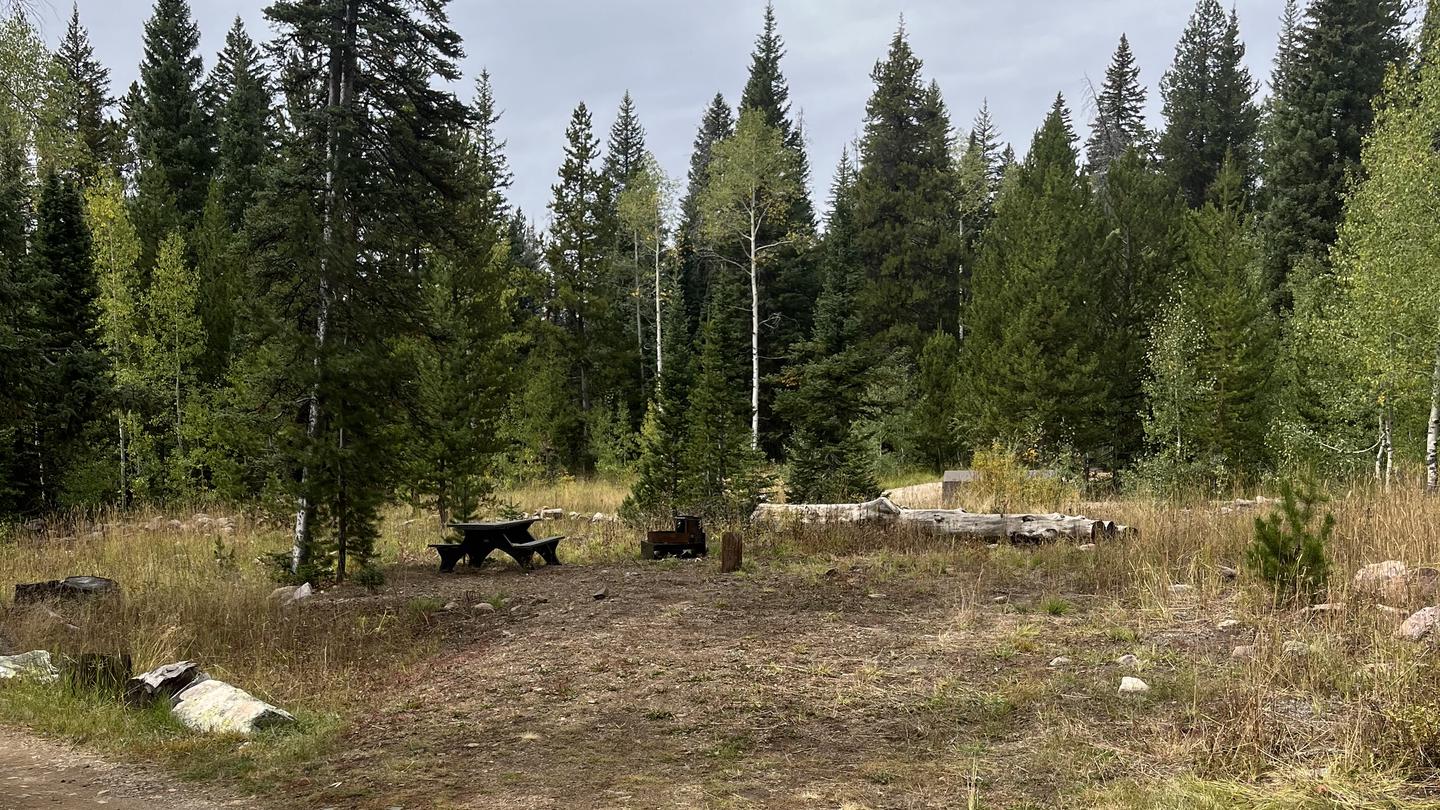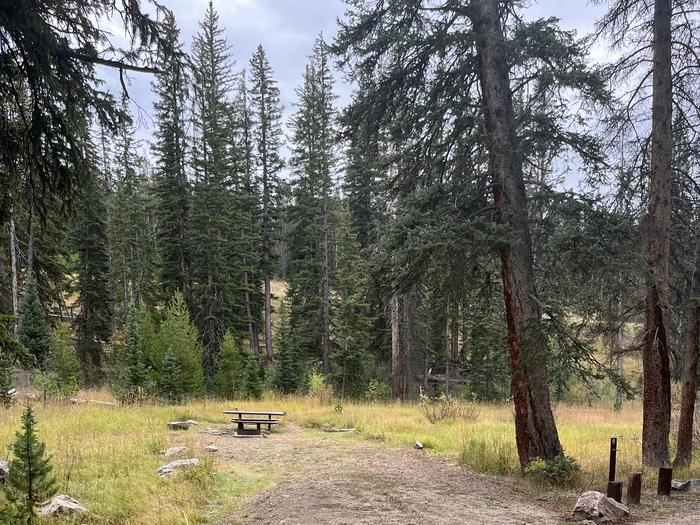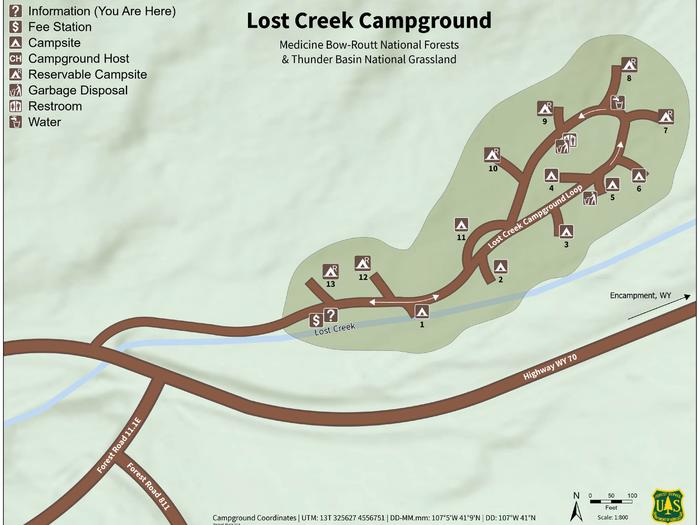1
Campground Day Use Calendar
mm
/
dd
/
yyyy
June | |||||||||||
|---|---|---|---|---|---|---|---|---|---|---|---|
Checking for available campsites | |||||||||||
Availability Table Bottom Menu
No Campsites Selected
June | |||||||||||
|---|---|---|---|---|---|---|---|---|---|---|---|
Checking for available campsites | |||||||||||
No Campsites Selected
Medicine Bow-Routt Nfs & Thunder Basin Ng
Lost Creek Campground is west of Encampment, WY on Wyoming Highway 70 and includes 13 small campsites (trailers under 22'), picnic tables, toilets, fire grates and trash service. Across the Highway the Baby Lakes Trail accesses the Huston Park Wilderness. Forest Road 811 provides ATV riding along the Huston Park Wilderness area boundary in the Battle Creek drainage. Highway 70 is an ideal scenic drive in summer and autumn.
Check-in time is after 2:00 p.m. on the first day of the reservation.
Check-out time is 1:00 p.m. on the last day of the reservation.
If the reservation holder doesn't show up on the first day of the reservation, the campsite is released at check-in time (2 pm) the next day.
There are no hookup services.
Maximum length of stay is 14 days.
Fires are only allowed in USFS approved metal fire rings.
Campsites are limited to 8 people and 2 vehicles per site.
Only 1 RV/trailer per RV campsite.
No RVs or camper trailers can park in parking spaces for walk-in tent campsites. These campsites and associated parking are for tent camping only.
Dogs must be on leash.
Quiet hours are 10:00 p.m. to 8:00 a.m.
You are responsible for reading the site descriptions and booking a site that will accommodate your equipment.
Check the elements
-What is in the skies? Check the weather report before you leave home. When you arrive at the site, keep on eye on the skies for changes and, if possible, carry a compact weather radio. In inclement weather, take shelter until the bad weather passes. Stay dry - wet clothes contribute to heat loss. Also, keep sleeping bags and important gear dry at all times.
-Are there forest or grassland alerts? Forest and grassland home pages post alerts you should know before you go. Many of our forests and grasslands also post alerts on Twitter. The latest fire information may be found on InciWeb.
Survey your surroundings
-Arrive early. Plan your trip so that you arrive at your actual campsite with enough daylight to check over the entire site and safely set up camp.
-Check for potential hazards. Be sure to check the site thoroughly for glass, sharp objects, branches, large ant beds, poison ivy, bees, and hazardous terrain.
-Avoid areas of natural hazards. Check the contour of the land and look for potential trouble spots due to rain or snow. Areas that could flood or become extremely muddy can pose a problem.
-Inspect the site. Look for a level site with enough room to spread out all your gear. A site that has trees or shrubs on the side of prevailing winds will help block strong, unexpected gusts.
-Pitch your tent in a safe spot. Make sure your tent is made of flame-retardant fabric, and keep it a safe distance away from campfires. Keep insects out of your tent by closing the entrance quickly when entering or leaving.
-Build fires in a safe area. Your open fires and fuel-burning appliances must be far enough away from the tent to prevent ignition from sparks, flames, and heat. Never use a flame or any other heating device inside a tent. Check to know whether there are fire restrictions in place before starting a campfire. You could be fined if you start a fire in a restricted area.
Be fire safe
-Keep fires small and bring firewood purchased in the local area. Firewood brought from another area could also bring invasive pests.
-If you have to collect firewood at your campsite, collect dead and down wood only.
-Check at the local ranger station for current fire restrictions, which can change on a daily, sometimes hourly, basis.
-Use existing fire rings. Scrape away litter and any other burnable material within a 10-foot-diameter surrounding the ring.
-Make sure all wood fits inside the fire ring. Do not feed a large log into the fire ring.
-Have a shovel, axe, and bucket of water available before lighting your campfire.
-Never leave a campfire unattended, even for a few minutes or even if there are no flames present. Many wildfires start because of abandoned fires or because someone thought a fire was out.
-Put out a campfire by slowly pouring water onto the fire and stirring with a shovel. Continue adding and stirring until all material is cool to touch.
-Do not bury your fire. The coals can smolder and re-ignite.
Be bear aware
Being outdoors means being with wildlife. Many people never encounter a bear. But if you do, here's some simple advice:
DO NOT RUN.
*Remain calm.
*Group together and pick up small children.
*Continue to face the bear and back away slowly, talking calmly to identify yourself as a human.
*If the bear continues to approach, try to scare it away by making yourself as large and imposing as possible by stretching your arms overhead and making loud noises.
*Carry and know how to use bear spray, which is available at many outdoor retailers and can be used to deter a charging bear.
Food Storage
Bears are always searching for food. Bears are curious, intelligent animals that have great memories. Their eyesight is similar to humans and their sense of smell is seven times more powerful than a blood hound’s, enabling them to smell food from miles away. Those are the very traits that can sometimes get them – and us – into trouble. Most bears are wary of humans and try to avoid them. However, bears can learn to associate people with food and be tenacious in their pursuit of something to eat. Even if humans are around.
Everyone in bear country must do our part to store food and other attractants in bear-resistant containers at all times, and dispose of trash in bear-resistant dumpsters.
THIS IS A GREAT HOME BASE IF YOUR LOOKING FOR HIKING TRAILS, BIKING, AND HUNTING DURING SEASON. YOU CAN ALSO FIND GREAT STREAMS FOR FISHING AND MANY CHANCES TO SEE WILDLIFE
For campground inquiries, please call: 307-326-5258
Learn more about gear rental options for your trip
From Encampment, WY: Travel west 18 miles on WY 70, Battle Highway.



Recreation.gov is your gateway to explore America's outdoor and cultural destinations in your zip code and across the country. We provide tools and tips to discover new adventures through a one-stop shop for inspiration and ideation, trip planning, information sharing, and reservations. Find incredible places and experiences that help you bring home a story through Recreation.gov!